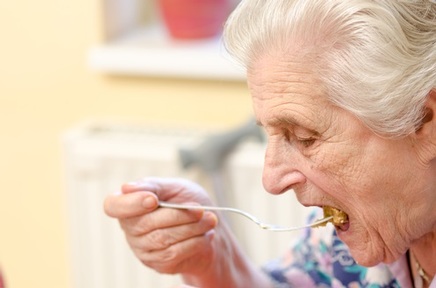Older people find 3D printed food easier to swallow
Care home residents could soon be tucking into 3D printed meals, after nursing homes gave it the thumbs up for taste and texture.

A 3D food printer has created tasty, nutritious and easy to swallow meals for older people, after three years of research and nearly €3m investment by the EU.
German firm Biozoon Food Innovations is leading the EU project Performance (Personalised Food for the Nutrition of Elderly Consumers) which involves 14 countries.
Melt in the mouth food for older people suffering from chewing and swallowing difficulties (dysphagia), has been designed using a Foodjet printer created by the Dutch company De Grood Innovations.
Unlike most dysphagia diets, which are based on purée and pre-mashed food and can mean a loss of appetite for the eater, 3D printed food replicates the look and taste of real food and is tailored to individual people's needs.
The meals are created using fresh ingredients which are bound together with a solidifying agent and injected into a 3D printer like ink.
It is then printed onto a plate and has a gel-like texture that looks like its original shape. Software tells the 3D printer to print any food shape required.
Getting as close to the original food shape was one of the main challenges faced by the Performance project team.
"Printed puréed food needs to be firm after printing but liquid enough to dispense from the printing heads," explains Pascal de Grood, founder and CEO of project partner Foodjet.
"‘We use a printing technology based on jet printing.
"A gelling agent supports the shaping of the puréed and strained food.
"On the one hand the gelling agent needs to be compatible with the printing system, while on the other hand the printing system must support food matrices such as meat, carbohydrate and vegetables."
Performance food uses only natural ingredients along with a natural texturiser to make the printed meal as close as possible to the real thing.
The food is enriched with nutrients based on an individual patient’s size, weight, gender and nutritional needs and these can be adjusted for a well-balanced diet.
This process is automated thanks to an algorithm created by German IT company Sanalogic. It monitors the nutritional status of each patient and automatically enriches the meals on a weekly basis.
Tasting sessions carried out at care homes have already resulted in good reviews from residents.
Project manager Sandra Forstner from Biozoon Food Innovations presented the results of tasting sessions at a meeting of the Performance consortium in Brussels.
She said: “The tastings tested the whole Performance system – from ordering personalised meals using the specially-developed software to the production and delivery of prototype food products which were reheated and served in the care home.
"Preliminary results show a generally positive reaction to the meal’s shape, appearance and taste.”
Some 54 per cent of care home residents rated the meal’s texture as good, 79 per cent found meals were equally heated and 43 per cent would choose a 3D printed meal if they had swallowing or chewing difficulties.
Biozoon project coordinator Matthias Kück admits that 3D food printing has some way to go until it becomes a viable commercial process however he says the team is working on “making the necessary breakthrough”.
Kück said: “You can expect many of the products developed within Performance to be commercialised as single-stand alone solutions very soon.”
Latest News
 29-Jul-24
Dementia Bus gives carehome.co.uk staff insight into life with dementia
29-Jul-24
Dementia Bus gives carehome.co.uk staff insight into life with dementia
 01-Mar-24
Find out the top care homes in 2024
01-Mar-24
Find out the top care homes in 2024
 21-Mar-23
UK's top care homes in 2023 revealed
21-Mar-23
UK's top care homes in 2023 revealed
 03-Jan-23
carehome.co.uk launches free care helpline
03-Jan-23
carehome.co.uk launches free care helpline
 13-Dec-22
5 mins with Emily Whitehurst, chief operating officer for Constantia Healthcare
13-Dec-22
5 mins with Emily Whitehurst, chief operating officer for Constantia Healthcare